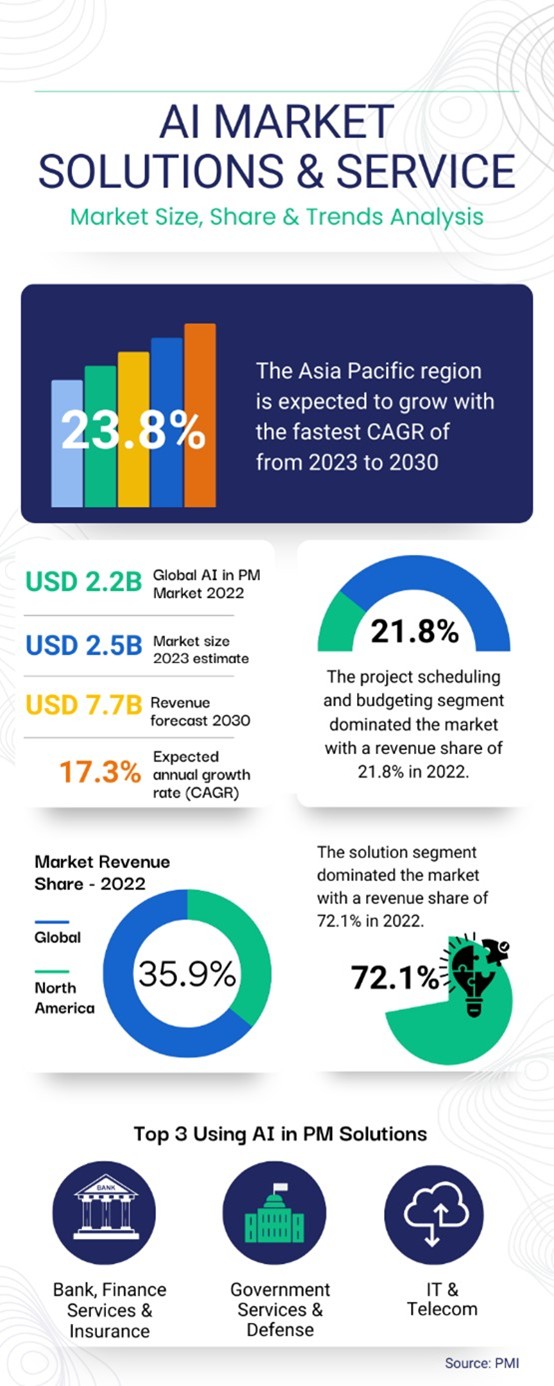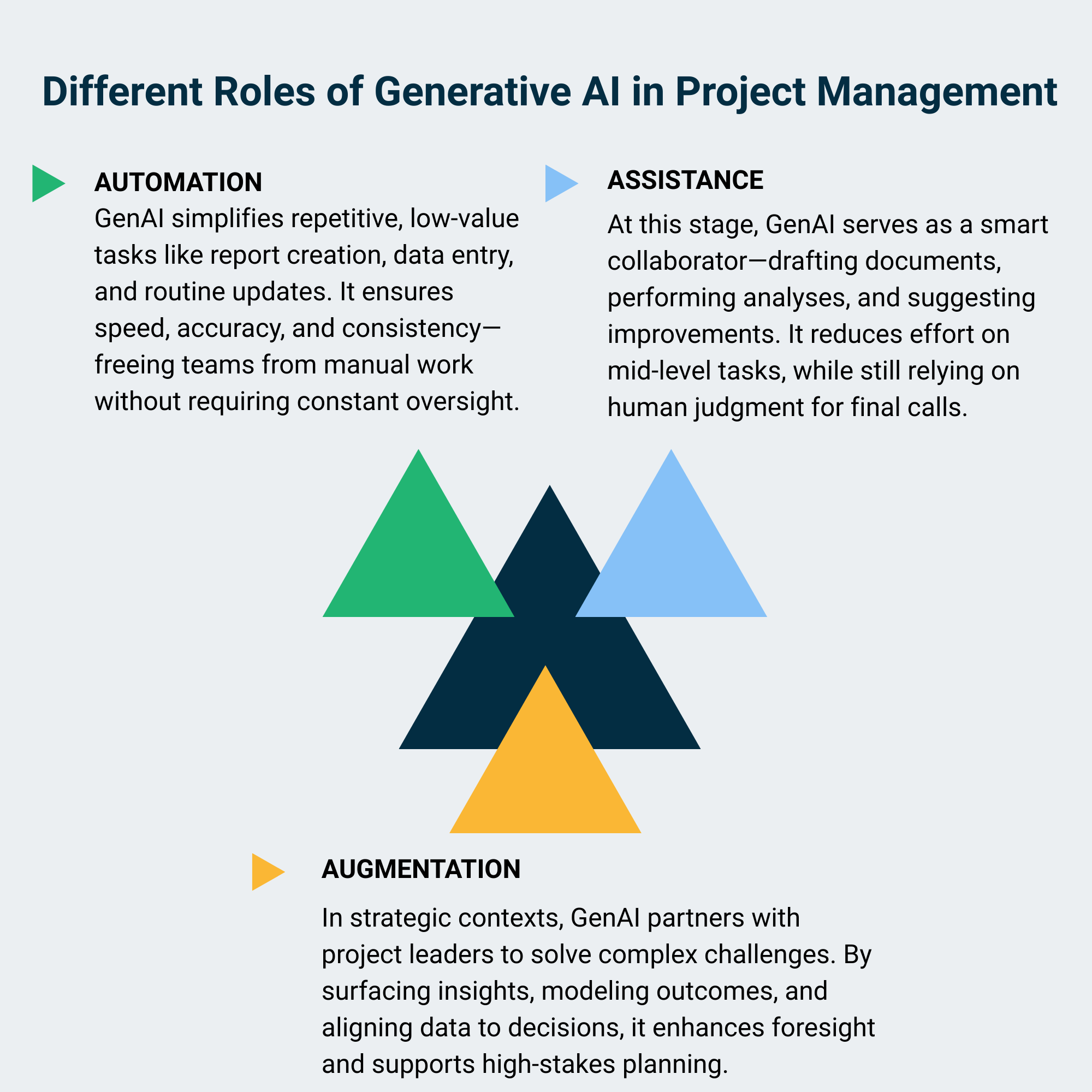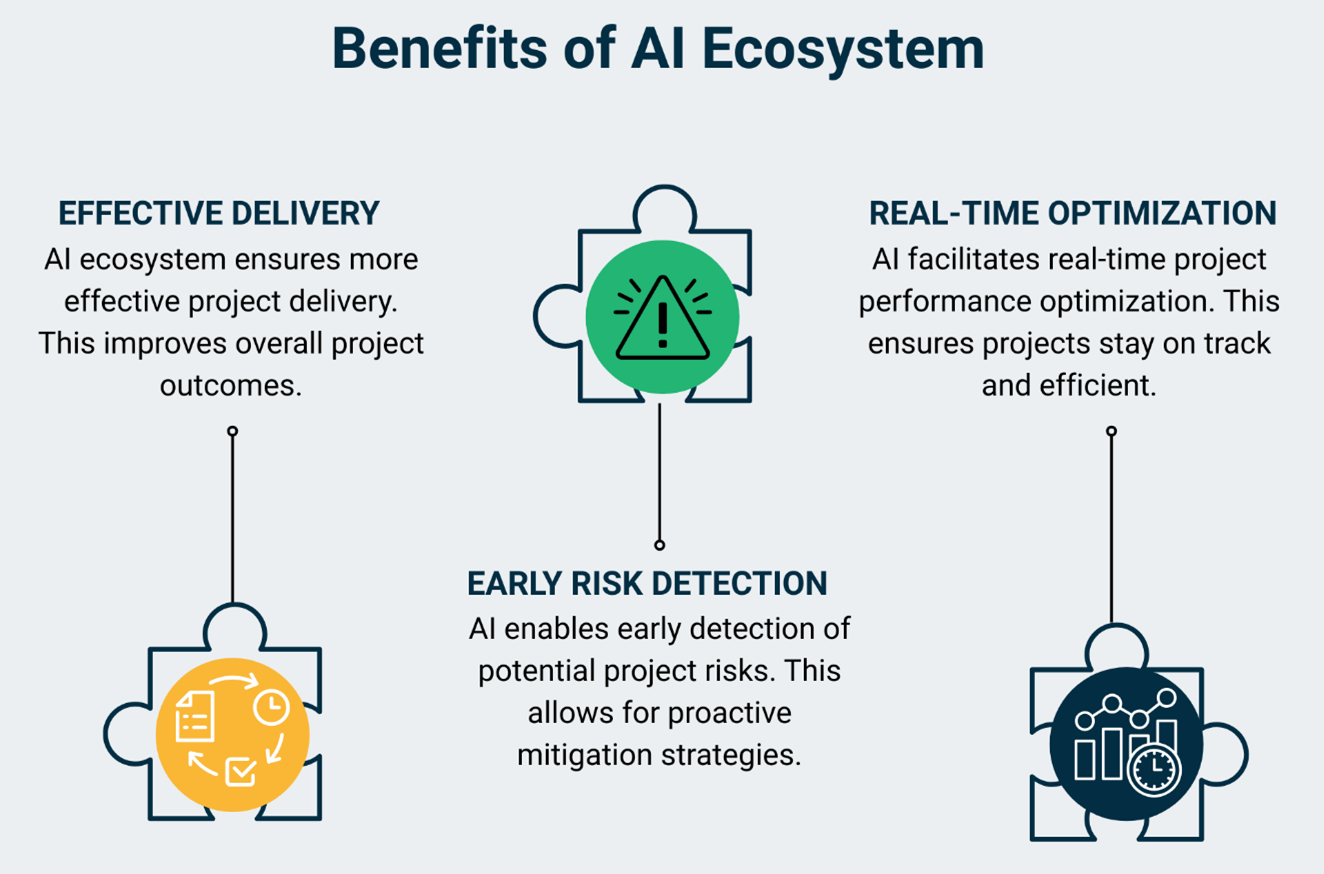
Quick Summary - Generative AI is reshaping project management by accelerating planning, enriching communication, and supporting smarter decision-making. This article explores how it enhances human-led execution—and how pairing it with predictive intelligence enables more proactive, outcome-focused project oversight.
Project success remains a persistent challenge: only 35% of projects meet their goals, timelines, and budgets, according to the 2022 CHAOS Report by the Standish Group. The culprits? Unseen risks, misaligned expectations, and communication gaps that turn well-planned initiatives into costly delays. In 2025, project managers face mounting pressure to deliver amidst rising complexity—global teams, tighter deadlines, and shifting priorities. The real hurdle isn’t just execution; it’s the ability to anticipate and adapt.
Generative AI is stepping in to bridge this gap, transforming project management from a reactive grind into a strategic partnership. An overwhelming majority—82% of senior executives—expect AI to play a pivotal role in shaping their project management strategies, signaling that AI adoption is quickly shifting from innovation to standard practice. Unlike traditional tools that focus on automation, generative AI acts as a co-creator, enabling project managers to tackle challenges with foresight and agility.
Imagine a project manager facing a tight deadline for a product launch. Generative AI analyzes past project data and market trends to draft a detailed project charter in minutes, suggests a stakeholder communication plan tailored to prior engagement patterns, and even proposes contingency plans for potential risks—all while leaving room for human refinement. This isn’t just about saving time; it’s about elevating the project manager’s ability to strategize, align teams, and deliver with confidence.
This article discusses the true power of generative AI to transform project workflows by anticipating needs and offering actionable insights. It’s not here to replace project leaders but to empower them, turning every project into an opportunity for innovation and resilience.
Want to see how foresight becomes your project team’s biggest advantage? Take a firsthand look at what generative AI can do.
The Co-Creative Potential of Generative AI in Project Management
 Generative AI is stepping into the role of a thought partner, not just a task handler. Its ability to bring both speed and perspective to complex project decisions sets it apart. This section explores how it’s being used as a creative collaborator, an intuitive enhancer, and a resilience-building force within project ecosystems.
Generative AI is stepping into the role of a thought partner, not just a task handler. Its ability to bring both speed and perspective to complex project decisions sets it apart. This section explores how it’s being used as a creative collaborator, an intuitive enhancer, and a resilience-building force within project ecosystems.
Beyond Automation: Generative AI as a Creative Collaborator
Forget automation for a moment. The true power of generative AI lies in its ability to co-create—producing ideas, content, and strategies that spark innovation. In project environments where speed and originality collide, this offers an edge that conventional planning tools can’t match.
Take a cross-functional product team, for example. Faced with tight timelines and unclear direction, they use generative AI to analyze prior launch campaigns, customer sentiment, and competitor moves. Within minutes, the system surfaces insights, suggests themes, and even drafts communication frameworks. What would’ve taken a week of brainstorming is now a launchpad ready in hours—with the human team refining from a higher starting point.
McKinsey’s 2023 research supports this shift, noting that 75% of generative AI’s business value lies in enhancing operations, marketing, and R&D—all deeply embedded in modern project workflows.ential staffing shortage mid-project. It not only projects delivery impact but also recommends backup resource models, alternative schedules, and client messaging—all in minutes.
This approach is what we call resilience forecasting—a shift from static risk logs to dynamic scenario planning. It helps project leaders do more than brace for change; it helps them prepare to thrive through it.
And the results back it up. According to a 2024 Capterra survey, 93% of project managers using AI tools reported improved ROI, especially in risk analysis and contingency planning.
Amplifying Intuition: Where Generative AI Complements Human Judgment
Project management has always demanded a balance between data and instinct. What generative AI offers is the ability to extend human intuition with deeper, faster insight. It detects subtle misalignments in communication or missed risks in milestone planning -all while learning from historical outcomes to offer more relevant inputs.
Let’s say a project manager is managing a globally distributed team. Generative AI detects subtle communication friction in internal emails, suggesting a tailored communication plan modeled after previous high-engagement messages. The result? A subtle but powerful boost in alignment—and one that no traditional report could have caught.
This is where human-AI synergy becomes tangible: AI surfaces patterns; humans interpret and act with emotional intelligence and business context. Together, they create a model of decision-making that is not only efficient but empathetic.
Execute projects smartly with built-in real-time insights. Explore our Quick-Start Plan
Simulating with Generative AI for Data-Driven Decision-Making

Projects fail not when risks occur—but when they aren’t anticipated. Generative AI offers more than historical analysis. It simulates the future. By generating multiple “what-if” scenarios, it gives leaders a sandbox to test uncertainties before they cause setbacks.
Picture this: a generative AI system runs multiple simulations for a potential staffing shortage mid-project. It not only projects delivery impact but also recommends backup resource models, alternative schedules, and client messaging—all in minutes.
This approach is what we call resilience forecasting—a shift from static risk logs to dynamic scenario planning. It helps project leaders do more than brace for change; it helps them prepare to thrive through it.
And the results back it up. According to a 2024 Capterra survey, 93% of project managers using AI tools reported improved ROI, especially in risk analysis and contingency planning.

How Generative AI Supports Modern Project Management
Generative AI is transforming project execution—not by replacing humans, but by scaling their impact across different levels of complexity. From automating repetitive work to supporting strategic analysis, its role evolves based on how much human judgment is needed. Here's a structured look at how GenAI fits into today’s project environments:
Automation: Simplifying the Routine
In low-complexity tasks that are repetitive and data-driven, GenAI significantly reduces manual effort by automating:
- Project status reports & summaries – AI tools compile real-time updates into digestible summaries drawn from active project data, removing the need for manual formatting.
- Auto-updates in PM tools – From task progress to timeline changes, GenAI ensures tools like Jira, Asana, or MS Project stay current without manual data entry.
- Scheduling assistance – Based on timelines, dependencies, and resource availability, GenAI recommends optimized task sequences and workload distribution.
- Operational quality checks – In contexts like manufacturing or engineering projects, AI can monitor logs, flag anomalies, and support standardization—minimizing oversight needs.
Assistance: Guiding with Intelligence
For mid-complexity tasks, GenAI serves as a digital assistant—enhancing insight while keeping the human in control. Use cases include:
- Drafting project documentation – From project charters to RACI charts, GenAI creates first drafts that teams can refine quickly.
- Proactive risk analysis – By learning from past project patterns, GenAI surfaces potential risks early—based on timeline changes, scope shifts, or team behavior trends.
- Scenario-based mitigation advice – Once risks are detected, GenAI proposes countermeasures aligned with what’s worked in comparable projects.
- Market insights & trend synthesis – For strategic programs (e.g., go-to-market or digital transformation), GenAI extracts relevant intelligence from large datasets to guide planning.
- Continuous health monitoring – AI benchmarks live performance data (budget, schedule, velocity) against internal standards to detect project drift before escalation.
Augmentation: Scaling Strategic Thinking
In high-stakes, high-complexity situations, GenAI augments leadership by enhancing decision-making with broad, context-aware insight. Examples include:
- Advanced scenario modeling – Project leads can explore “what-if” pathways based on predictive simulations, enabling better preparation for uncertainty.
- Complex decision support – By integrating data across stakeholders, finance, delivery, and risks, GenAI highlights patterns that shape more confident, multidimensional decisions.
- Business case development – GenAI supports the creation of robust business cases, analyzing opportunity cost, ROI potential, and strategic alignment in stakeholder-ready formats.
Addressing Generative AI Challenges in Project Management
Generative AI offers significant value—but to implement it effectively, leaders must address a few key challenges:
- Data Privacy - AI tools often require access to sensitive project and organizational data. Ensuring compliance with standards like GDPR and HIPAA is non-negotiable.
- Training Data Quality - The performance of GenAI depends on diverse, accurate, and bias-free data—yet sourcing and maintaining such datasets is both complex and resource-heavy.
- Workforce Integration - AI adoption can disrupt existing workflows. Teams need intuitive tools and training to use GenAI confidently and effectively.
To unlock Generative AI’s true potential, organizations must balance innovation with ethical safeguards and operational readiness.
Curious how leading teams prevent project drift before it begins? Discover our real-time insights in action with the Quick Start Plan.
The Role of Predictive Intelligence in Amplifying Generative AI
Predictive intelligence adds that missing layer. It uses real-time and historical data to forecast outcomes, surface early risks, and guide smarter resource decisions. If generative AI is the creative cockpit, predictive intelligence is the control tower.
For example, a PM might use generative AI to draft three resource plans. Predictive models then evaluate each against past data, assessing the probability of success and recommending the most viable option—saving up to 15% on resource costs, according to a 2024 Springer study.
Together, these technologies transform scenario planning. Generative AI creates options. Predictive intelligence quantifies them, enabling preemptive action. A 2023 PMI survey confirms this: 60% of experts say predictive analytics significantly improves risk and opportunity planning.
Predictive intelligence enhances project tracking through:
- Real-Time Analytics - Continuous updates on KPIs like budget, timelines, and team productivity.
- Early Warning Systems - Alerts on risks—like scope creep—before they escalate.
- Resource Optimization - Dynamic allocation based on evolving project health.
By combining generative and predictive AI, project managers shift from reacting to leading—ensuring every milestone is informed, aligned, and future-ready,
What if your next project came with early warnings, smarter scenarios, and sharper decisions—built in? Explore how predictive intelligence makes it possible.

The Future of Project Management: A Co-Creative Operating Model
As generative AI and predictive intelligence converge, project management is no longer a sequence of tasks—it’s an intelligent, adaptive system. This shift is already unfolding, redefining how teams lead, plan, and deliver in high-velocity environments.
Project Leaders: From Executors to Strategic Integrators
Project managers are no longer tasked with simply driving execution. Their role is evolving into one of orchestration—interpreting AI insights, aligning delivery with business value, and guiding adaptive decision-making.
By 2026, over 80% of enterprises are expected to adopt generative AI (SPR, 2024). Those who pair it with predictive oversight will gain the real edge—less firefighting, more foresight.
While generative AI produces drafts, simulates scenarios, and accelerates documentation, predictive intelligence monitors live project conditions—surfacing deviations, triggering alerts, and recommending corrective paths. Together, they create a closed-loop system that improves both speed and strategic control.
Enabling the Shift: Culture First, Then Technology
Successful integration of AI into project workflows requires more than adoption—it demands intent. This transformation must be led from the top, with clear incentives for experimentation, training, and trust in AI-augmented insights.
A 2024 MDPI study found that organizations combining generative ideation with predictive tracking saw a 40% increase in project success rates. Why? Because AI wasn’t deployed as a tool—it was embedded into the fabric of how projects were planned, fast tracked, and optimized.
This calls for more than plug-and-play solutions. It requires a mindset shift—from managing tasks to managing intelligence.
What's Next: A New Standard for Delivery
As AI becomes more embedded, project leaders will be judged not just by delivery timelines—but by how effectively they navigate ambiguity, surface signals early, and adjust course proactively.
The future-ready project environment isn’t reactive—it’s responsive by design. Leaders who embrace this co-creative model will move faster, manage smarter, and deliver outcomes that are aligned, optimized, and continuously improved.
Conclusion: A 360-Degree Vision for Project Success
Generative AI has redefined project management—elevating how ideas are formed, decisions are made, and teams align in real time. It’s not just enhancing workflows; it’s enabling project leaders to think faster, act smarter, and respond with agility. This article has shown how generative AI moves beyond automation to become a co-creative force in project ecosystems. But even the smartest ideas fall short without foresight. Because innovation without direction still risks derailment.
To lead with confidence—not just efficiency—project managers must move from intelligent creation to intelligent prediction. That’s where predictive intelligence becomes the game-changer.
TrueProject is the best logical solution built to power this AI-driven evolution in project management. It fuses predictive intelligence with project insight, enabling early detection of emerging risks, behavioral misalignments, and delivery gaps before they turn into problems. With stakeholder sentiment analytics, adaptive KPI monitoring, and proactive guidance rooted in real-world signals—not lagging data—TrueProject equips leaders with the clarity to act before impact. It transforms complexity into control, uncertainty into direction, and progress into performance.
Don’t just integrate AI—lead with it. See how predictive intelligence turns blind spots into foresight and project chaos into control. Start your evolution with TrueProject today.
FAQs
- What is generative AI in project management?
Generative AI creates content like plans, reports, or risk scenarios using existing project data to support smarter decisions and faster execution. - How does generative AI help project managers?
It automates repetitive tasks, speeds up documentation, and provides strategic insights—freeing up managers to focus on high-impact work. - What are the top use cases for generative AI in projects?
Common use cases include AI-generated project reports, risk simulations, stakeholder communications, and real-time documentation. - What are the risks of using generative AI in projects?
Key risks include data privacy concerns, biased outputs, and over-reliance without human oversight or proper training. - How do I start using generative AI in my projects?
Begin by automating simple tasks, piloting tools on low-risk projects, and effectively training your team to interpret AI-generated insights.






